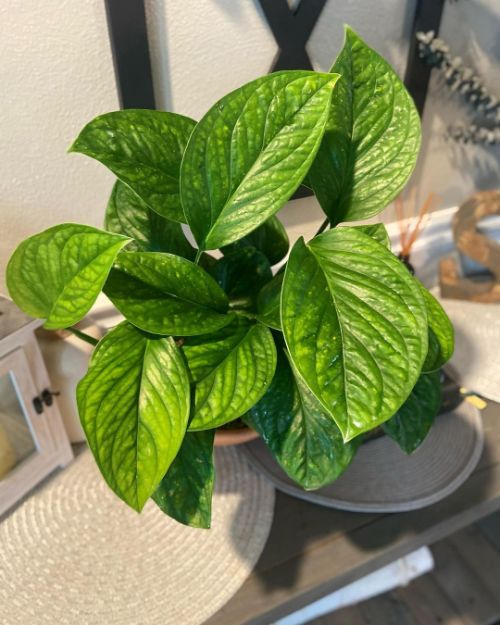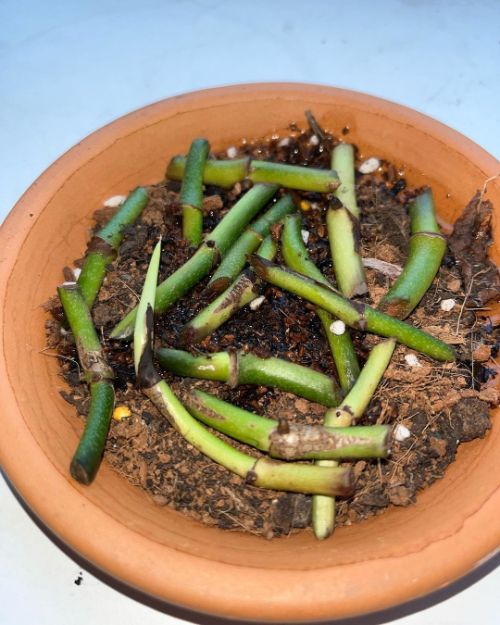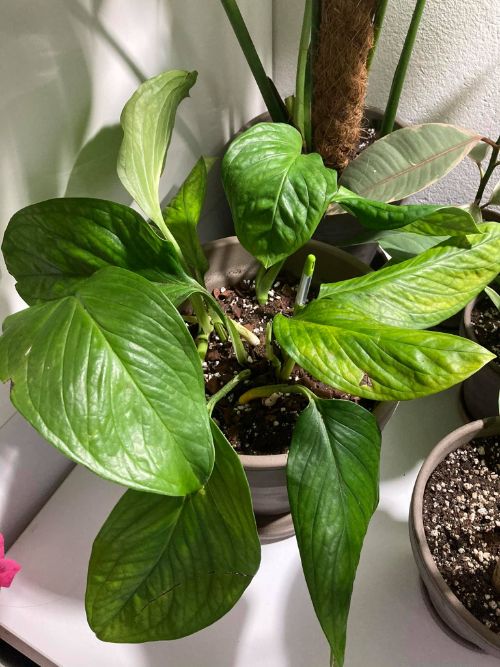Monstera pinnatipartita is the go-to plant for anyone looking to add a bold and eye-catching touch to their place! With its awesome leaves that have their own unique split-leaf shapes and beautiful bright green color, it’s easy to see why this colorful beauty has turned into a favorite indoor plant. But being popular means you’ve got to know what you’re doing, since Monsteras need you to know the ins and outs of caring for them so they can be their best. In this guide, you’ll get everything you need to know about Monstera Pinnatipartita care, some handy tips to keep your plants in good shape, advice on making more of them, what to do about bugs & sick plants – and loads more – all to help you grow your own Monstera at home!
What is a Monstera Pinnatipartita?
Monstera pinnatipartita is a tropical looker that’s pretty awesome in both its young and grown-up forms in the Monstera family, where you’ll see it showing off two different leaf shapes. This plant comes from Central and South America, and like its cousin, the well-known Monstera deliciosa, it’s got big, gorgeous green leaves. But unlike its relative, when grown-up, Monstera pinnatipartita’s special leaves turn into deep-split leaves that are laid out like a feather – that’s why it’s got the scientific name of ‘pinnatipartita’. Whether you want it indoors as a houseplant or outside as part of a cool garden collection, the Monstera pinnatipartita kind will definitely brighten up your space with its lively leaves.

Monstera Pinnatipartita care overview
| Botanical Name | Monstera pinnatipartita |
| Common Name | Monstera pinnatipartita, Monstera pinnat |
| Family | Araceae |
| Genus | Monstera |
| Mature Size | Up to 6 ft (2 m) tall and 3 ft (1 m) wide |
| Soil Type | Rich, well-draining soil |
| Soil pH | 6.0 to 6.5 |
| Native Area | Central America and South America |
| Temperature | 65-85°F (18°C to 29°C) |
| Light | Bright, indirect light, can tolerate some direct sun |
| Watering | Maintain a moist but not waterlogged soil; allow the top inch of soil to dry before watering again. |
| Humidity | High humidity is preferred, but normal room humidity can be tolerated. |
| Fertilizer | Using a balanced fertilizer on a monthly basis during the growing season |
| Propagation | By stem cuttings or by dividing the plant |
| Toxicity | Non-toxic to pets and humans |
How to care for Monstera Pinnatipartita?
Monstera pinnatipartita is an easy-to-spot and pretty plant that needs some regular love to stay in top shape. Here’s what you need to do to take care of Monstera pinnatipartita:
Light Requirements
The trick to getting the lighting right for Monstera pinnatipartita is to give it bright but not direct sunlight. It can handle a bit of direct sun, but too much can make its leaves turn yellow and burn. So, keep this plant near a window where it gets bright but not direct sunlight. Monstera pinnatipartita likes different light depending on the time of year. In summer, keep it in bright light but out of the direct sun, while in winter it can handle more direct sunshine. To make sure your Monstera pinnatipartita grows up strong, make sure it gets plenty of light.

Soil
For soil, Monstera pinnatipartita likes it damp and well-draining. Soil that’s right in the middle with a pH of 6.0 to 7.0 is just right, as soil that’s too acid or too base can mess with its growing. You’ve got to make sure the soil doesn’t dry out all the way, as that can stress out the plant and slow it down.
Giving it too much water can also be bad, so let the top inch of soil dry out before giving it more. You can mix in things like perlite, peat moss, and compost to help the soil drain and give the plant the good stuff it needs. These add-ins make sure that Monstera pinnatipartita gets the best care and has all it needs to grow up strong.
Watering
Watering your Monstera Pinnatipartita is a must for it to live long and look great. Water it on the regular, letting the top inch of soil dry out before giving it more. Don’t let the soil get all soggy, as that can cause the roots to rot and give your plant problems. Give it enough water to keep the soil damp but not soaking wet. Watering your Monstera Pinnatipartita the right way will keep it looking good for years.
If you’ve just got your Monstera Pinnatipartita, be sure to change how often you water it as needed. Give it more water when it’s hot out and less when it’s cooler to help it get used to its new digs. Watering your Monstera Pinnatipartita just right keeps it happy and healthy in its new spot.
If you’re not sure if the soil is too dry or too wet, stick your finger in the soil near the roots. If it feels dry, give it some water. Water your Monstera Pinnatipartita until you see a little water coming out the bottom of the pot. This lets you know you’ve given it enough, and it’s soaked in just right.
Temperature
When it comes to temperature, Monstera pinnatipartita likes it cozy, around 65-85°F (18-29°C). But since it’s not a common plant, finding the right spot for it can be a bit tricky. To keep it going strong and help it grow right, keep a close eye on the temperature for Monstera pinnatipartita and make sure it’s comfy.

Humidity
Keeping the dampness right for Monstera pinnatipartita is key, as too much or too little can stress out the plant and slow down its growth. Around 70-80% dampness is just right, and you can check this with a little gadget called a hygrometer. To make the air damper, you can spritz the leaves every now and then or stick a humidifier in the room. Or, put a tray of water close to the plant to add some moisture to the air.
You need to check the soil often and water it when it starts to feel dry to keep the dampness just right for your Monstera pinnatipartita. Keep the dampness in check by keeping it out of direct sun, as that dries out the moisture on the leaves. And keep your plants away from heaters and other hot things that can dry out the air. Check the dampness now and then to make sure your Monstera pinnatipartita is getting the right amount of moisture to grow best.
Fertilizer
Feeding your Monstera pinnatipartita should be a steady thing, using a water-mixable food and not overdoing it. Giving it too much food can burn the roots, especially on young plants, so start small and add more as the plant gets older.
Feed it during the growing time (spring to fall) with half the usual amount, once a month. Giving it a leaf spray in the middle of summer can also be good and helps the plant take in more food. Plus, it’s a good idea to rinse the soil with water now and then to wash away any salt buildup from the food. This helps make sure your Monstera pinnatipartita gets what it needs to grow up strong.
Repotting
Changing pots for Monstera Pinnatipartita is a regular job you’ve got to do to keep your plant happy and growing right. When you change pots, pick one a little bigger than the one it’s in now, and use fresh soil that’s made for tropical plants. Do the repotting in the spring or summer when the plant’s growing like crazy.

When you’re ready to switch pots, start by gently pulling your Monstera Pinnatipartita out of its old pot. Then, shake off any extra soil around the root ball and snip away any broken or dead roots before moving the plant to its new pot. Fill the pot with fresh potting soil and spread the roots so they’re all around in the container. After you’ve done this, fill in any gaps around the root ball with soil and give it a gentle press to make sure there aren’t any air pockets.
Give your Monstera Pinnatipartita a good watering after you’ve repotted it and put it somewhere with bright but indirect light. Keep the soil moist but not all sopping wet to make it grow strong and healthy.
Pruning
Trimming up your Monstera pinnatipartita is a big part of taking care of it because it helps to keep the plant in good shape, helps it grow new bits, and keeps it looking neat. Here are some tips on how to do that:
- Snip off yellow or damaged leaves: It’s normal for older leaves to go yellow and drop off when new bits are growing. These leaves should be snipped off to keep the plant looking sharp and stop any bugs from moving in.
- Trim back long stems: If your Monstera pinnatipartita has stems that are growing long and leggy, you can cut them back a bit to encourage bushier growth. This will also get the plant to put out side shoots and leaves.
- Cut back shoots: To keep your Monstera pinnatipartita from getting too big, cut back the shoots that grow from the main stem. This will help keep it looking good and stop it from getting too huge.
- Remove old aerial roots: Aerial roots are roots that grow out from the stem of the plant and help it stick to the host plant where it naturally lives. If these roots aren’t needed anymore, you can snip them off to keep the plant looking clean.
When you’re doing your trimming, make sure to use sharp, clean tools to get nice clean cuts. Try not to leave any stubs, as they can let pests and diseases get in. Plus, it’s a good idea to do your trimming when your Monstera pinnatipartita is in its growth phase in the spring or summer, as this will encourage new growth and help the plant bounce back quickly.
Related: Monstera Lechleriana Care And Grow: The Ultimate Guide
Monstera Pinnatipartita Propagation
Growing a new Monstera pinnatipartita from your existing one isn’t too hard. You can either do it with stem cuttings or by splitting the plant up. Here’s how you can do both:
Stem Cuttings
Find a healthy stem that’s got one or two nodes (those little bumps on the stem where leaves pop out).
- With a sharp, clean pair of scissors or shears, snip the stem just under a node.
- Let the cut end of the stem dry out for a few days by leaving it out in the open. This helps keep it from rotting.
- Fill a pot with soil that drains well and give it a good soak.
- Poke a hole in the soil and stick the stem cutting in, making sure one node is under the soil.
- Water it again after packing the soil around the stem.
- Put the pot somewhere bright and warm, but away from direct sun.
- Keep the humidity up by keeping the soil damp but not soggy, and spritzing the leaves every so often.
- Give it a few weeks and roots should start poking out from the node that’s buried. Once the roots show up, you can switch the cutting to a bigger pot.

Division
Another way to grow a new Monstera pinnatipartita is by dividing it.
Carefully take the Monstera out of its pot and look for “pups” – little plants growing out from the main stem.
- Gently pull the pups away from the main plant and give them their own pots.
- Make sure the pups are planted so the bottom node is covered, which helps roots grow.
- Fill up each pot with soil that drains well.
- Water the soil and keep it as moist as you would for any Monstera pinnatipartita.
- Put the pots somewhere warm and damp, away from direct sunlight, and give them a mist now and then.
- In a few weeks, the little plants should have roots and can be moved to bigger pots if they need it.
Growing a new Monstera pinnatipartita takes some patience, no matter which way you choose to do it. It can be a few weeks before roots start to show up and the new plant really gets going.
Pinnatipartita Monstera Common Pests & Plant Diseases
Like a lot of other houseplants, Monstera pinnatipartita can get hit by bugs and get sick. Here’s a list of the usual suspects and what you can do to fix ’em:
Pests
- Spider mites: These tiny bugs mess up leaves by leaving yellow or brown spots, ’cause they suck the plant’s sap. Wash the plant with water and a bit of soap to kick the spider mites out, and you might also want to use a special spider mite bug spray.
- Mealybugs: Mealybugs are small, white bugs that suck plant juice and leave sticky stuff behind. Use bug-killing soap or a cotton swab with alcohol to wipe ’em off the leaves and stems.
- Thrips: Thrips are little, long bugs that munch on plant juice and can mess up the color and shape of leaves. Use a thrips-killing bug spray or let good bugs like ladybugs or green lacewings loose to take care of thrips.
Diseases
- Root Rot: Root rot is basically a fungus that pops up when a plant’s roots chill in water for too long. Make sure your pot drains well and that the soil isn’t drenched to avoid root rot. If root rot has already moved in, you might need to put the plant in a new pot with fresh soil and snip off any sick roots.
- Powdery Mildew: Powdery mildew is a fungus that looks like a white, dusty coating on the plant’s leaves and stems. Make sure your plant gets plenty of fresh air and isn’t too crowded to dodge powdery mildew. If your plant has already got a case of powdery mildew, you can use a fungicide that’s made just for it.
You can lower the risk of pests and diseases going after your Monstera pinnatipartita by giving it top-notch care, which means bright, indirect light, plenty of humidity, and soil that drains well. If you end up with a pest or disease problem, it’s super important to deal with it ASAP so it doesn’t spread and cause even more damage.
Monstera Pinnatipartita Care Common Problems
Taking care of Monstera pinnatipartita is usually pretty easy, but like any houseplant, it might act up from time to time. Here are some usual problems you might run into with your Monstera pinnatipartita, along with ways to fix them:
- Yellowing Leaves: If the leaves are turning yellow, it might be because of over-watering, under-watering, or not having enough nutrients. Play around with the watering a bit to make sure the soil isn’t too wet or dry, and think about giving the plant a good, all-around fertilizer to clear this up.
- Wilting Leaves: Wilting leaves could mean over-watering, under-watering, or not enough humidity. Adjust how you water to keep the soil just right, and maybe mist the leaves or use a humidifier to make the air more moist around the plant.
- Brown Spots: Brown spots on the leaves might be a fungus, bugs, or too much sun. Snip off any bad leaves, be careful not to over-water, and try moving the plant out of direct sunlight to fix this.
- Slow Growth: If your plant is growing too slow, it might be because of not enough light, crummy soil, or too much fertilizer. Give it more bright, indirect sunlight, maybe repot it in better soil, and ease up on the fertilizer to kick-start the growth.

FAQ about caring Monstera Pinnatipartita
Is Monstera Pinnatipartita toxic to cats?
Yes, Monstera pinnatipartita isn’t a friend to cats. If a cat munches on any part of this plant, it could end up with vomiting, diarrhea, drooling, and even serious stuff like difficulty breathing or heart problems. If you’ve got a cat and want a Monstera pinnatipartita, maybe pick another plant that’s not toxic. If you’ve already got one, keep it away from your cat to avoid any accidents.
Why are my Monstera Pinnatipartita leaves curling?
Curly leaves usually mean too little or too much water. If your Monstera Pinnatipartita isn’t getting enough water, it might start curling its leaves. But too much water can do the same thing, especially depending on where you live and how hot and humid it is.
Other things like not enough nutrients or too much direct sun could cause problems too. To fix it, check your watering first, and then see if other stuff like light and humidity might be stressing your plant.
Is monstera pinnatipartita rare?
Well, it depends on what you mean by rare. All over the world, Monstera pinnatipartita isn’t rare at all. But if you’re talking about houseplants, it’s kind of special and hard to find because of its cool-looking leaves.
Conclusion
Monstera pinnatipartita is a cool, sturdy houseplant that can brighten up your space. It’s pretty easy to care for, but you might run into a few issues. Just remember to give it lots of bright but indirect light, be careful with the watering, and maybe mist the leaves or use a humidifier to keep the air moist. Monstera pinnatipartita is a bit of a rare find among houseplants, so take good care of it!
Follow these Monstera Pinnatipartita care tips from FamiPlants, and you’ll have a happy and healthy plant at home! Enjoy having this awesome addition to your space. Happy gardening!
Other Monstera Aesthetics and Value Rarity:

